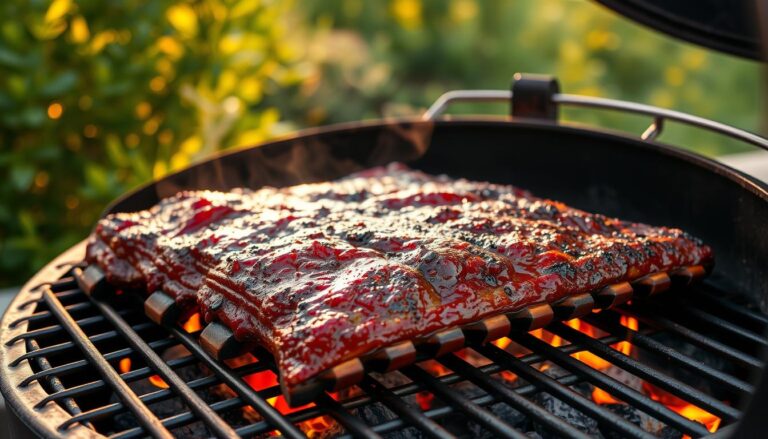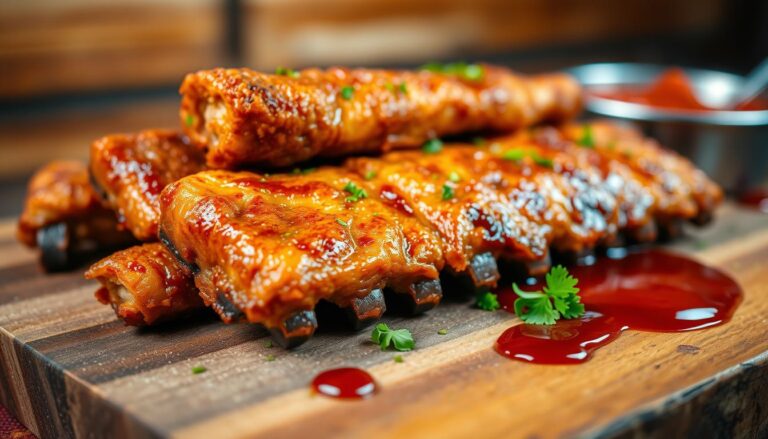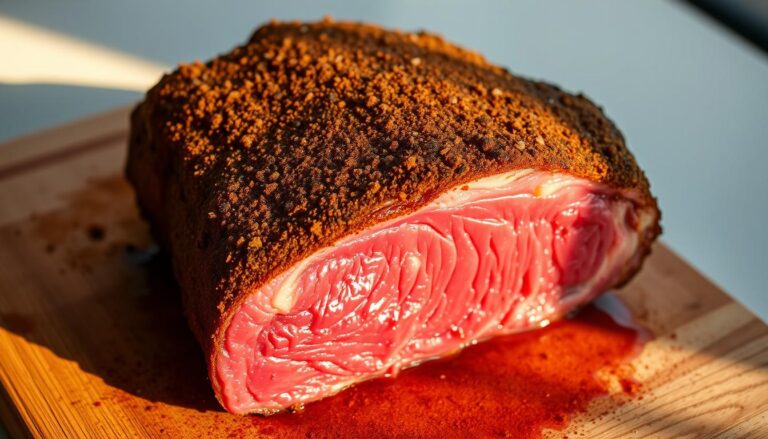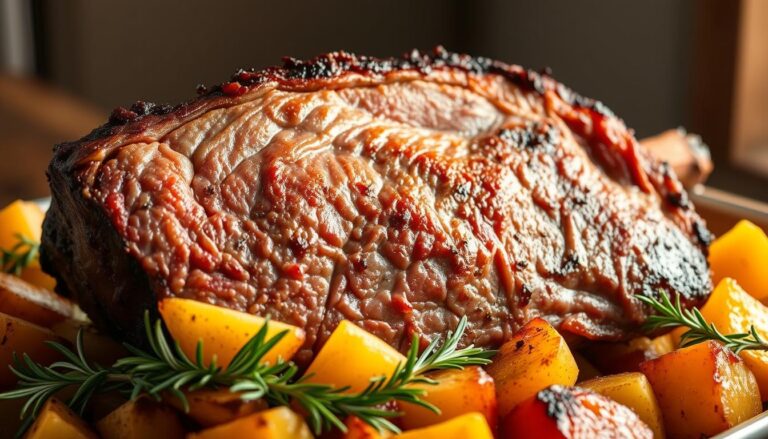How to Cook Ribeye Roast: 5 Proven Tips for a Perfect Meal
Imagine the sizzle of a hot pan and the rich smell of garlic and herbs. Then, picture the excitement of a perfectly cooked roast that makes everyone stop and stare. That’s what a ribeye roast is all about—a dish that’s both impressive and easy to make.
This recipe makes cooking a ribeye roast simple, turning you into a kitchen pro. Whether you’re new to cooking or have years of experience, learning how to cook a ribeye roast is key. It turns a basic cut of meat into a meal that your guests will talk about for weeks.
It’s easy: just a simple dry rub and 75 minutes in the oven. The trick is to let the meat’s natural fat and flavor do the work. You don’t need complicated steps. Just sear it in a skillet, slow roast it, and let it rest to keep the juices in. And that’s it—a dish that feels like a big celebration without the hassle.
Table of Contents
What is a Ribeye Roast?
Many people get confused between ribeye roast and prime rib. But, it’s easy to tell them apart. A ribeye roast comes from the rib section of the cow. It’s known for its marbling, which makes it tender and flavorful.
Whether you like it bone-in or boneless, knowing where it comes from is important. It helps you cook it perfectly.
Understanding Different Cuts of Ribeye
- Bone-in vs. boneless: Bone-in roasts stay moist, while boneless ones are simpler to slice.
- USDA Grades: USDA Prime has the most marbling, followed by Choice and Select grades.
- Serving size: A 6-pound roast feeds 6-8 people, perfect for big gatherings.
The Anatomy of a Ribeye Roast
The ribeye roast’s fat cap and marbling keep it juicy. The grain direction is crucial for slicing to avoid toughness.
“The fat is your friend—retains moisture and enhances flavor,” say butchers.
When cooking, the fat cap melts into the meat, adding richness. The longissimus dorsi muscle’s structure means slicing against the grain ensures tenderness. Keep this in mind when planning your recipe for the best results.
Selecting the Perfect Ribeye Roast
Choosing the right ribeye roast is key to a great meal. Start by learning about USDA grades for quality. A 3-pound roast is perfect for 3-4 people, offering both flavor and size.
Choosing the Right Grade
USDA grades show the meat’s texture and taste. Here’s what to look for:
- Prime: Lots of marbling (white fat streaks) for juiciness. Ideal for special occasions.
- Choice: Some marbling, a good choice for everyday meals.
- Select: Leaner, less tender but still tasty with proper cooking.
Fresh vs. Frozen Ribeye
Go for fresh if you can. If frozen, pick vacuum-sealed to avoid freezer burn. Let it thaw in the fridge for 24 hours before cooking.
Pro tip: Bone-in roasts are better. Bones add flavor. For bigger groups, choose a 4-5 pound roast.
Quality starts with the right ingredients. Look for bright red meat. Grayish color means it’s too old.
Preparing the Ribeye Roast
Mastering the ribeye roast recipe begins with careful preparation. Trimming and seasoning are crucial steps. They help unlock the roast’s natural flavor and tenderness.
Trimming and Tying the Roast
Start by trimming off excess fat, leaving a thin 1/4-inch layer on top. If your roast is uneven or loose, tie it with butcher’s twine every 2 inches. This keeps its shape during cooking.
This step ensures even heat distribution. It also prevents overcooking.
Seasoning Options for Flavor
For the ribeye roast recipe, use a basic seasoning blend. Mix 1 tablespoon kosher salt, 1 teaspoon black pepper, and 1 teaspoon garlic powder. Rub the mixture into the meat, pressing firmly.
For extra flavor, add 2 teaspoons each of fresh sage, thyme, and rosemary. Plus, 1 teaspoon each of parsley and minced garlic.
- Optional: Melt 1/2 cup unsalted butter and brush it over the seasoned roast before cooking.
- Let the roast sit at room temperature for 1 hour before cooking. This ensures even heat absorption.
Professional chefs recommend avoiding over-seasoning. This lets the beef’s natural juices shine.
Follow these steps to enhance your ribeye roast recipe. Proper preparation ensures the roast stays juicy and flavorful once cooking begins.
Cooking Methods for Ribeye Roast
Learning how to cook a ribeye roast is all about choosing the right method. Two top choices are oven roasting and outdoor grilling. Both methods promise great taste and tenderness. Use a meat thermometer to guide you to perfect results.
Roasting in the Oven
For oven cooking, start with a reverse sear:
- Preheat your oven to 500°F. Let the roast sit at room temperature for 30 minutes.
- Put the roast fat-side up on a rack in a roasting pan. Make sure to insert an oven-safe thermometer into the center.
- Roast at 500°F for 15 minutes to create a crust.
- Then, lower the oven to 350°F. Keep cooking until the thermometer shows 135°F (medium-rare). The total time will depend on the roast’s size: 15 minutes at high heat plus 1 hour for a 3-pound roast.
- Let the roast rest for 15–20 minutes before slicing.
| Doneness | Target Temp (Cooking) | Resting Temp |
|---|---|---|
| Rare | 115–120°F | 125–130°F |
| Medium | 125–130°F | 135–140°F |
| Well Done | 160–170°F | N/A |
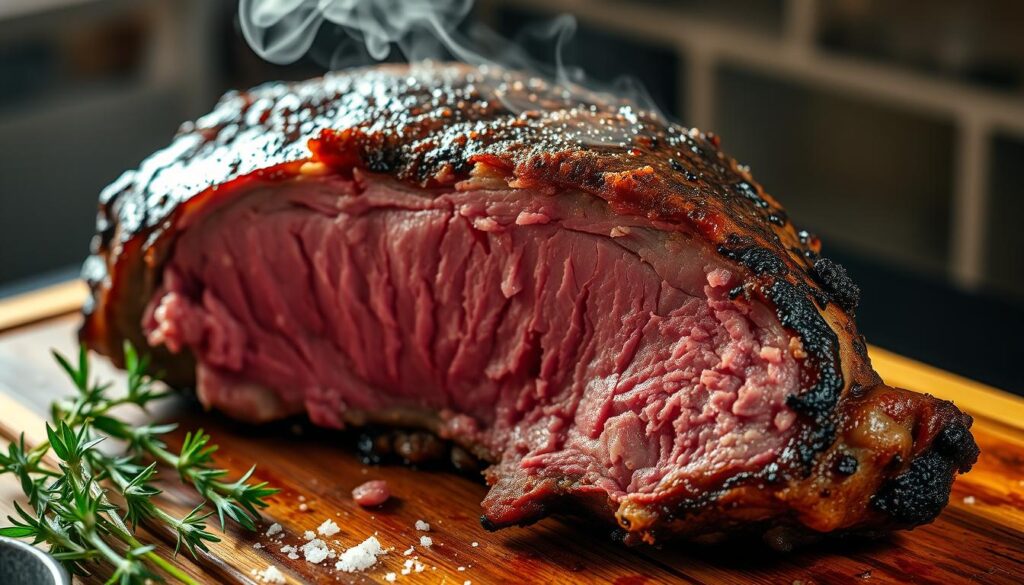
Grilling Techniques for Ribeye
Grilling a ribeye roast adds a smoky flavor. Follow these steps:
- Preheat your grill to 350°F with indirect heat zones.
- Place the roast on the indirect side. Close the lid and cook until the thermometer reaches the target temp (e.g., 135°F for medium-rare).
- Optional: Add wood chips like hickory for extra flavor.
- Rest the roast 15–20 minutes before serving.
Ideal Cooking Temperatures
Mastering ribeye roast cooking tips starts with knowing internal temperatures. A meat thermometer makes cooking precise. Follow these steps for perfectly cooked meat every time.
Understanding Doneness Levels
Choose your doneness based on these internal temperatures:
- Rare: 125°F (red center, soft texture)
- Medium-rare: 135°F (pink center, firm texture)
- Medium: 145°F (minimal pink, evenly cooked)
- Medium-well: 150°F (mostly brown, dry edges)
Take the roast off the heat 5–10°F before your target. Carryover cooking will finish it while it rests.
Using a Meat Thermometer
Start with the right placement. Put the thermometer in the thickest part of the roast, away from fat or bone. Tip: For big roasts, check different spots.
- Use instant-read thermometers for quick checks or leave-in probes for continuous monitoring.
- Remove from heat when 5–10°F below desired temp to avoid overcooking.
- Rest the roast 20–30 minutes post-cook to let juices redistribute.
Ignoring thermometer readings can lead to dry meat. Focus on internal temperature over cooking time for success.
Resting and Slicing the Roast

Resting and slicing are key steps in cooking a ribeye roast. Skipping them can spoil the meat. Here’s how to keep the meat juicy and tender.
Importance of Resting
Let the roast rest for 30 minutes after cooking. Hot muscles push out juices. Resting lets proteins relax and soak up moisture.
Place the roast on a cutting board, loosely cover with foil. Avoid tight covering to prevent steam buildup. This keeps the meat from getting soggy.
How to Slice the Ribeye
Use sharp knives to cut fibers cleanly. Slice against the grain to make the meat tender. Aim for ½-inch slices.
Thick cuts dry out, and thin slices lose heat too fast. This is why the right slice thickness is important.
| Step | Action |
|---|---|
| Resting Time | 30 minutes at room temperature |
| Slicing Angle | Cut perpendicular to muscle fibers |
| Serving Suggestion | Arrange slices on a warm platter |
After resting, use a carving knife. Rotate the roast 90 degrees to find the grain direction. Serve warm. Leftover slices should be refrigerated within 2 hours.
Delicious Ribeye Roast Accompaniments
Make your ribeye roast recipe even better with sides and drinks. Choose items that balance its bold flavors. Pair rich, savory cuts with dishes that add brightness, crunch, or contrasting textures.
Side Dishes to Consider
Here are some categories to help you create a great meal:
| Category | Popular Options | Why They Work |
|---|---|---|
| Vegetables | Sautéed Green Beans with Pomegranates, Roasted Carrots with Honey Butter | Acidity and herbs cut through the meat’s fat |
| Starches | Mashed Potato Casserole, Crock-Pot Mac and Cheese | Comforting textures that complement robust flavors |
| Sauces | Au Jus, Horseradish Cream | Elevate simplicity with bold, fresh flavors |
Wine Pairing Suggestions
Here are some drink options to go with your ribeye roast recipe:
- Bold Reds: Cabernet Sauvignon, Malbec, or Syrah for tannin balance
- Alternatives: Smoky craft beers or spiced apple cider for non-wine drinkers
Try classic sides like Creamed Spinach or Duchess Potatoes for elegance. Or, go for easy options like Slow Cooker Green Beans to save kitchen space. Remember, 30% of top sides feature potatoes, and 20% highlight greens like Brussels sprouts or asparagus.
Storing Leftover Ribeye Roast
Get the most out of your ribeye roast with these ribeye roast cooking tips for leftovers. Storing it right keeps it juicy and safe. You can enjoy it cold or reheat it later.
Refrigeration Tips
- Keep sliced or whole roast in an airtight container for 3–4 days.
- Reheat in the microwave at 50% power to avoid dryness.
- Try it cold as a sandwich topping with Dijon mustard or sriracha mayo.
Freezing for Later Enjoyment
Wrap meat tightly in plastic wrap, then aluminum foil. Vacuum-sealed bags are also good. Frozen leftovers stay fresh for up to 3 months.
- Thaw in the fridge overnight before reheating.
- Add broth or gravy when reheating to keep it moist.
- Use slices in hash, tacos, or salads for quick meals.
These tips ensure every bite of your ribeye roast stays delicious. From fridge storage to freezer prep, adjust leftovers to your liking. Enjoy quality beef without wasting any.
Troubleshooting Common Issues
Even with the best ribeye roast method, unexpected issues can happen. Here’s how to adjust and save your meal:
What to Do if Your Roast is Overcooked
If your roast turns out tough, slice it thinly against the grain. This helps tenderize the fibers. Serve it with a red wine reduction or au jus to add moisture.
Overcooked meat is great in sandwiches or stews. Here, the texture doesn’t matter as much. The USDA suggests resting the roast at 145°F for 3 minutes. But, overcooked meat can be quickly fixed.
Fixing Flavor Problems
Under-seasoned? Drizzle with melted butter—try ¼ cup before seasoning—to boost richness. Lack of browning? Use a kitchen torch or return the roast to a hot skillet for 2 minutes per side.
For bland flavor, increase salt and pepper by 50% or add fresh herbs like rosemary. Always use a meat thermometer to hit target temps like 135°F for medium-rare. If the roast’s doneness varies, slice and return undercooked pieces to a preheated 375°F oven for 2-3 minutes.
Remember, cooking ribeye roast isn’t about perfection—it’s about flexibility. Adjust seasoning, repurpose leftovers, or serve with bold sauces to highlight what’s salvageable. With these fixes, you’ll still enjoy a satisfying meal.


